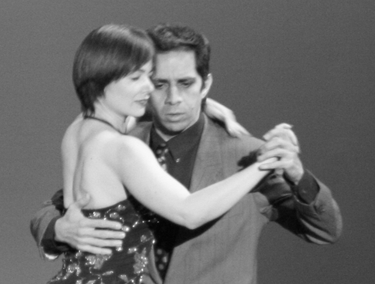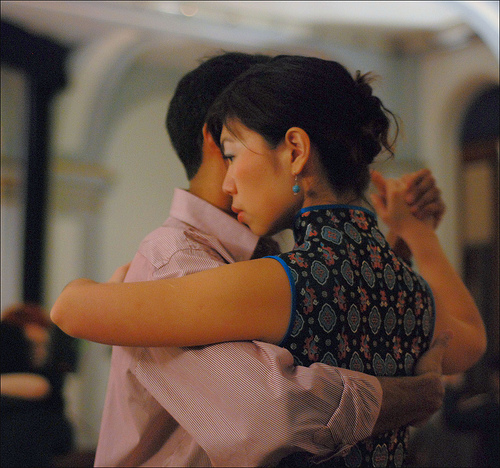The embrace: V Embrace
The Doctor: Oh! Hello! Sorry, is this your office? Had a sort of collision with my... vehicle. Faults on BOTH sides, let's say no more about...
*Hitler straightens up*
The Doctor: ...it. ~ Doctor Who ("Let's Kill Hitler")
8th September 2011
- Introduction
- What's the point of it?
- Lightbulb moment - V is for Volcada
- Other variations
- Conclusion
- Related articles
Introduction
(See The Embrace for a general article on this area.)
Caveat 1: it's very easy to become far too "label-obsessed" when defining the embrace. The embrace is a spectrum not a binary or trinary system, there are infinite variations of embrace, and it's good to be flexible in these things. That said, some degree of categorisation is often useful.
One of the things I've been exploring recently is the "V embrace" - that is, a close embrace where the partners are offset from each other, with there being more space between the partners bodies towards the "open" side (leader's left, follower's right) of the embrace. I found that the easiest way to achieve this is for the woman to snuggle basically against my, ummm, armpit, but there may be a better way to describe that position...

This contrasts with a parallel or "square" embrace:

What's the point of it?
Until recently I never really saw the point of this V-embrace. It seemed like an embrace adopted by people who didn't really understand the core concepts of Tango, but who simply wanted to "look good" and do flashy moves.
I mean, the V looks dramatic, and in fact it's the same style you see in a lot of show tango performances and pictures, but it seemed like hard work for the follower (the leader just has to stand facing forwards, men always have it easy) to achieve the offset, and a lot of the time followers who try to achieve an upper-body twist seem to do so by pushing excessively with her right hand against the leader's left hand, which can cause discomfort.
So it just seemed like a lot of work, purely to achieve a visual effect. Which is fine if you're dancing a performance, but ridiculous if you're dancing socially.
So, last year, I simply accepted that this was an incompatibility issue, and if my partner insisted on attempting a V, I knew that it'd be a problem.
Lightbulb moment - V is for Volcada
However, as often happens in Tango, some aspect of a class will explain something, often unrelated to the topic of the class itself (which is one reason why I still go to group classes). In my case, this was a class on volcadas and colgadas, in Sussex at the end of May, which clarified a few things for me.
Initially, from that class, it became clear that Volcadas in a V embrace were by far the best way to do these movements, from both a stability and a health point of view. As I said at the time:
The most important point I learnt in the entire weekend: Volcadas are safer, and cause less back strain, if they're "sideways" leans - that is, instead of leaning straight forward (thus creating pressure on both partners' backs), if the woman leans more on her left side, leaning onto the man's right side, then there's a lot more stability. Our bodies are much better at taking "side strain" than "forwards strain".
And also:
It's a very good, practical reason for using the V embrace. As the V embrace is naturally "diagonal", a volcada movement in V makes much more sense.
So, we can clearly and unambiguously say that volcada-type movements justify the V embrace, for pure, mechanical and unarguable reasons; this is not "opinion", this simply a question of how our bodies are put together.
Other variations
So, great. But no-one dances volcadas all the time, so that seems a fairly specialised use of a specific embrace to achieve a specific effect... It's difficult to justify adopting a fairly-hard-to-maintain embrace, simply to do a volcada every now and then.
However, it occurred to me, a couple of months after the initial insight, that this embrace change also works well for other movements; in fact, it makes such movements natural.
For example, the cross. If the woman's upper body is naturally angled diagonally, then it's much easier to bring the lower body around in line, and take a diagonal step in that direction. Which is essentially a description of a cross step. And it's much easier to lead a cross step if you're slightly offset from your partner. Which is why patterns such as the Basic 8 build in this offset as part of their pattern, but it's better if this offset is built-in to the embrace from the start.
So cross steps (and variations such as ochos cortado) are easier under V.
Similarly, any movements which involve clockwise rotation (such as a clockwise giro) may be easier to initiate - it's easier to rotate towards the open side of the embrace if the open side is more open. In a parallel close embrace, a clockwise giro is difficult to initiate with a follower forward step - you'd typically initiate it with a sidestep or backstep. But in a V embrace, it's easy to initiate an anti-clockwise giro with the follower starting with a forward step.
"What has the V ever done for us?"
So, now we have a number of steps which can be easier and more natural under a V system:
- Volcadas
- Giros
- Crosses
(There are likely to be others)
So that's already a substantial subset of movements that can be used in V. In fact, arguably, some of them only work in V.
The V style in dancing
There are some interesting implications for style of dancing. Because many / most of the "more natural" movements in a V embrace involve some degree of rotation, it's rational that people who adopt that embrace will, in social dancing, naturally gravitate to the types of move which are most comfortable under that embrace.
And whilst I've not done any exhaustive study of this area, my casual observations have resulted in seeing that people in a V tend to dance in precisely that way. Lots of rotations, lots of crosses, and so on.
(Now, arguably, this is chicken-and-egg; these people like doing those specific steps, so they tend to adopt the embrace which best facilitates those steps. But I think it's best practice to assume that the embrace comes first.)
Example - The Dome
I regularly attend milongas at the Dome in North London. One of the things I've noticed there over the past couple of years is that my partners there have adopted more and more of a V-style of embrace.
And until recently, I was finding this more and more uncomfortable to dance with those people - I was presenting a parallel embrace, they were attempting a V embrace, and much wrestling ensued...
However, in the past few months, with my brand new thinking, and as it's clear that most of the dancers in that milonga are "V-ers", I've started adopting that specific style and those specific steps myself.
So far, it's had some sucess.
Extra bonus - height difference
(Here's something that became clear when trying out the V embrace at a practica session last night.)
If the leader is significantly taller than the follower, then achieving a good embrace in parallel is quite tricky. Putting it bluntly, the follower's face gets in the way - you have to twist your neck or perform other contortions before you can create a good contact with your partner. It's do-able, but it can be hard work.
In V embrace, this problem (largely) disappears - there's an element of offset, so that the follower can achieve a connection along her left side without having to squash her nose against her partner's chest.
Conclusion
I'm definitely not saying "go out and adopt a V embrace right now" - there's a perfectly good argument for saying that you can simply modify a parallel close embrace (opening it out a little) to achieve a "V shape" for specific steps such as those outlined above, then re-adopting a parallel embrace after those steps have been taken.
It's also a reasonable point that close parallel embrace is the more natural, intimate and connected embrace; it allows more scope for musical improvisation and deep connection, and it's easier to walk in. So there's a good argument that a V embrace is not the best way to start learning Tango.
I also take the point that many people adopt a V embrace simply because it looks cool, and because it allows them to do some showy steps. And many more people adopt a V embrace badly, or simply do it because that's the way they've been taught it, without considering other possibilities. Certainly, you will lose some intimacy, and you will lose some "walk-only" based dancing, adopting the V, and if those are most important to you, don't do it.
In fact, I'm not even sure I even like the V embrace. At the moment, it's fairly new to me. I'll work at it... All I'm saying is, I can now see some good, social-dance-based, justifications for it, under certain circumstances.
Hopefully, now, so can you.
~ David Bailey, 8th September 2011